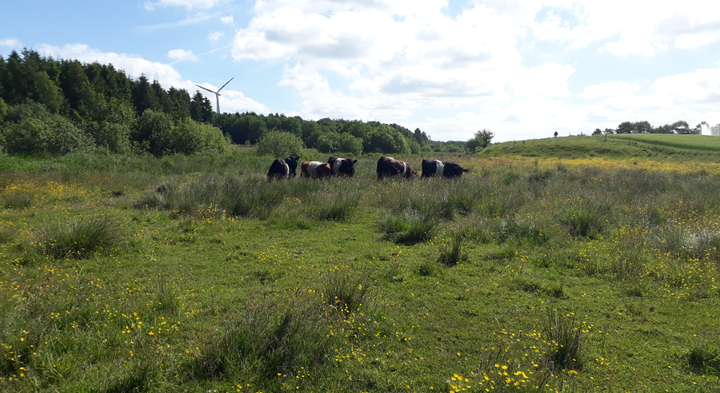Twenty years on, biodiversity struggles to take root in restored wetlands
While the restoration of natural areas is high on political agendas, a comprehensive new study from the University of Copenhagen shows that – after more than two decades – biodiversity growth has stalled in restored Danish wetlands. The results also suggest that time alone will not heal things because the areas are too small and dry, and nitrogen inputs from agriculture continue. According to the researchers, we need to learn from the past.

The benefits are clear: natural areas with high biodiversity absorb CO2 and can help struggling marine environments by reducing nitrogen emissions.
The establishment of wetlands ranks high among the green priorities of politicians in Denmark and many other countries. And with the new Green Tripartite Agreement between the government, industry, agriculture and environmental groups, Denmark plans to invest significantly in restoring natural areas in coming years, with the creation of new wetlands being a key focus.
However, new research from the University of Copenhagen’s Department of Biology emphasizes that these initiatives must be executed with careful consideration. The study, which is the first detailed investigation of biodiversity in restored wetlands in Denmark, describes the restoration of Danish wetlands as a "modest success." Despite decades of restoration efforts, biodiversity has stalled far from the goal line.
"Our study shows that species richness is significantly lower in restored wetlands than in original, natural wetlands. Furthermore, these areas are dominated by a few competitive species, while rarer and more vulnerable plants and mosses fail to establish themselves. In fact around one third of species found in near natural wetlands are missing, and it's all the rare species that are missing," explains Marta Baumane from the University of Copenhagen’s Department of Biology.
Few to no moss species were to be found after the restorations, and the species-rich genus “Carex”, typical of natural wetlands, were also underrepresented in restored wetlands. Researchers found only five common species of Carex in restored areas, compared to ten different species in the near natural wetlands.
Baumane is the lead author of the study, now published in the scientific journal Journal of Applied Ecology. The researchers examined plant biodiversity using available data on wetlands across Denmark and their own fieldwork at 12 different sites in three river valleys: Omme, Odense, and Tryggevælde. All of the wetlands studied were reestablished after 2000.
Time will not heal it
The results also make it clear that allowing for more time is not the solution to struggling biodiversity, as long as the underlying causes remain unchanged.
"If we waited another 20 years and returned, it is doubtful that we would see any significant improvements. Using the registry data, we can look back and find records showing that these areas have stagnated for the past 10 years. We must assume that this is due to a number of underlying factors that have yet to change. High concentrations of nitrogen remain in the soil and though the streams have been meandered again, they are often still in deep river channels, so the wetlands along them are too dry," says Marta Baumane.
In part, nitrogen residue comes from the land’s previous use for high-input farming, but it also continues to flow in from neighbouring areas with active farming.
At the same time, the research reports that many areas are too small and affected by incomplete watercourse restorations. These areas still show signs of dredged rivers and streams, as well as artificial drainage systems, which continue to dry out the land and, according to the researchers, prevent a natural ecosystem from developing in restored wetlands.
Grazers, meandered streams and no dirty drainage is the way
Recognizing the problems should be the first step toward solving them if you ask the researchers. Based on their new research, Baumane and her colleagues highlight several concrete measures that could improve biodiversity in both older and more recently restored wetlands.
One of the key recommendations is the use of grazing animals. The study shows that grazed restored wetlands have significantly more plant species richness compared to areas that have been left unmanaged. Indeed, grazers create a more diverse landscape, with favourable conditions for a wider range of species.
"In particular, grazing reduces the overgrowth of tall grasses, which makes space for low-growing plant species and mosses that would otherwise be outcompeted," explains Marta Baumane.
At the same time, the researchers recommend that efforts be made to reduce the amount of nutrient-laden drainage water discharged from surrounding fields and ensure full restoration of watercourses so that the areas have the right conditions to become true wetlands.
Natural grazing, water conditions and less nutrients are easier to achieve in larger contiguous areas than in small isolated areas surrounded by agriculture. The researchers' recommendation to create larger areas also harmonizes with a final recommendation for future projects, namely that they are placed near existing natural areas with high biodiversity, from which plants and other organisms can spread to the new wetlands.
A failure to prioritize biodiversity
According to the researchers, the projects included in the study reflect a political approach to wetland restoration where the primary goal has been to reduce nutrient inputs into waterways so as to improve freshwater and marine environments. Essentially becoming open air waste water treatment plants. They point out that biodiversity is frequently mentioned in project descriptions, but without a clearly defined objective.
“If we continue to treat the country's natural areas one-sidedly as a technical solution to our nutrient and CO2 emissions, it will continue to cost us biodiversity,” emphasizes Marta Baumane, who is supported by co-author Professor Hans Henrik Bruun from the Department of Biology.
"To avoid repeating the same mistakes in new wetland areas, biodiversity should be prioritized in future projects, for example in connection with the Green Tripartite. If Denmark is to achieve its biodiversity goals, it requires a much more ambitious effort," he says.
*
Facts: Moss is a strong indicator
Few - often no - moss species were found in the new wetlands studied. Research shows that the diversity of mosses is high in semi-natural areas, while dense grass vegetation in restored wetlands leaves no room for them. Mosses can therefore be important indicators of biodiversity in wetlands. The researchers suggest that mosses can be used to assess whether restoration projects are on the right track.
Facts: No natural wetlands in Denmark, only near-natural
Denmark is so extensively cultivated that even the wetlands that the researchers used as a reference, i.e. a natural basis for comparison, are also highly influenced by humans and could not be described as fully natural.
Even though these areas have not been cultivated, they are so small and isolated, surrounded by agriculture and without natural watercourses etc. that an actual natural state is not present. Instead, researchers coined the term “near-natural”.
Facts: About the Study
• The study aims to assess the restoration of wetlands.
- More specifically, it examines how the area's fertilization history, stream restoration, grazing, and species pool in the surroundings influence the achieved plant diversity compared to near-natural wetlands.
• The study was conducted on two spatial scales: landscape and local site.
- At the landscape level, monitoring data from 48 restored wetlands across Denmark were used (including data on grazing density, water conditions, soil type, and other variables).
- At the local site level, researchers compared vegetation, soil moisture, and nutrient levels in wetlands in three river valleys: Omme, Odense, and Tryggevælde. In each valley, four types of wetlands were studied: restored wetland with grazing [RG], restored ungrazed [RU], near-natural grazed [NG], and near-natural ungrazed [NU].
Behind the research
The following researchers where part of the research project - all from the Department of Biology, University of Copenhagen:
Marta Baumane
Lars Baastrup-Spohr
Kaj Sand-Jensen
Irina Goldberg
Kenneth Thorø Martinsen
Hans Henrik Bruun
Keywords
Contacts
Hans Henrik BruunProfessorDepartment of Biology, University of Copenhagen
Tel:+45 35 32 12 11hhbruun@bio.ku.dkMarta BaumanePhD FellowDepartment of Biology, University of Copenhagen
Tel:+45 35 33 04 83Tel:+45 60 12 62 32marta.baumane@bio.ku.dkKristian Bjørn-HansenJournalist and Press ContactFaculty of Science, Copenhagen University
Tel:+45 93516002kbh@science.ku.dkLinks
ABOUT THE FACULTY OF SCIENCE
The Faculty of Science at the University of Copenhagen – or SCIENCE – is Denmark's largest science research and education institution.
The Faculty's most important task is to contribute to solving the major challenges facing the rapidly changing world with increased pressure on, among other things, natural resources and significant climate change, both nationally and globally.
Subscribe to releases from Københavns Universitet
Subscribe to all the latest releases from Københavns Universitet by registering your e-mail address below. You can unsubscribe at any time.
Latest releases from Københavns Universitet
P-piller kan forringe kvinders mentale trivsel2.12.2025 06:05:00 CET | Pressemeddelelse
Adgang til p-piller i ungdomsårene er forbundet med øget risiko for depression senere i livet. Især kan kvinder, der er genetisk disponeret for psykisk sygdom, risikere at blive ramt af bivirkningen. Det viser et nyt studie fra Københavns Universitet.
Psykologer: Derfor kan protester samle folk på tværs af politiske skel27.11.2025 09:18:05 CET | Pressemeddelelse
Hvordan kan mennesker med diametralt modsatte holdninger pludselig stå skulder ved skulder i protest? Det spørgsmål har et internationalt forskerhold undersøgt. Udgangspunktet er COVID-protesterne, som blev båret af tre samlende strategier.
Sådan bruger planter ingeniørprincipper til at trænge gennem hård jord27.11.2025 07:16:00 CET | Pressemeddelelse
Et internationalt forskerhold med Københavns Universitet, Shanghai Jiao Tong University og University of Nottingham i spidsen har opdaget, hvordan planterødder er i stand til at trænge igennem hård og tæt jord ved hjælp af et velkendt ingeniørprincip. Opdagelsen kan få stor betydning for fremtidens afgrøder i en tid, hvor presset på landbrugsjorden stiger.
Forskere advarer: Klimaforandringer kan udvide levesteder for malariamyg27.11.2025 06:00:00 CET | Pressemeddelelse
Hvis vi ikke begrænser klimaforandringerne, så risikerer vi, at malariamyg udbreder deres levesteder i Afrika betydeligt. Det vil udsætte mange hundrede millioner mennesker for en højere smitterisiko.
Plants use engineering principles to push through hard soil26.11.2025 17:01:00 CET | Press release
An international research team led by the University of Copenhagen, Shanghai Jiao Tong University and the University of Nottingham has discovered how plant roots penetrate compacted soil by deploying a well-known engineering principle. The finding could have major implications for future crop development at a time when pressure on agricultural land is increasing.
In our pressroom you can read all our latest releases, find our press contacts, images, documents and other relevant information about us.
Visit our pressroom